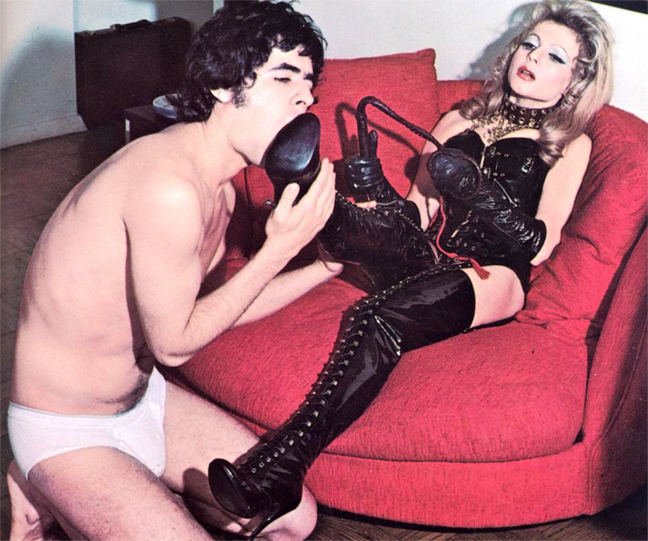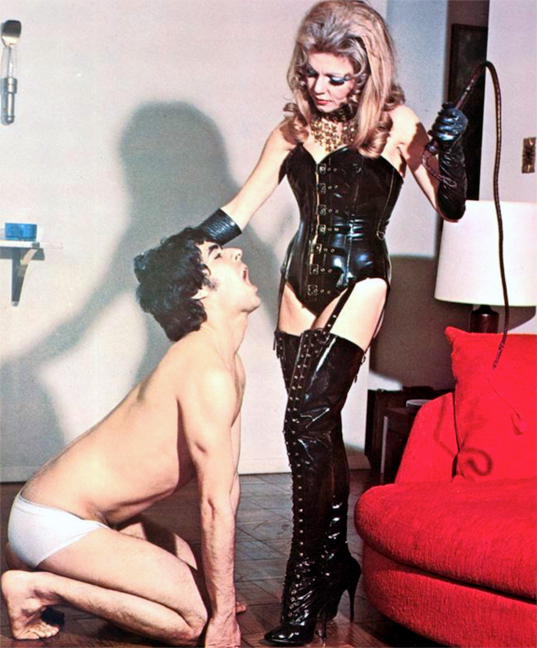I always enjoy posting and gently poking fun at the fashions and tropes of vintage fetish shots. However, I should make clear that I’ve the utmost respect for the people who created them. They were operating at great legal risk, with very limited funds and no easy way to distribute their material. They had no blueprint for what BDSM material should look like and no easy way to get customer feedback. Sex workers today complain – with total justification – about the limits credit card companies and social media impose. Yet the idea of being able to simply snap and tweet an image would blow the mind of a 60’s fetish photographer. They had to deal with printing physical magazines, postal inspectors keen to sieze their material, paper mailing lists of nervous customers and the mob money that funded a lot of pornography.
If, like me, you love reading stories about the early days of kinky porn, then I’d highly recommend this Rialto article on Leonard Burtman and his wife/model Jutka Goz (aka Jennifer Jordan). Using a photograph of Jutka dominating Jamie Gillis as jumping off point, it tells the story of Leonard Burtman, one of the pioneers of kink and femdom porn. Along the way it touches on such famous names as Weegee, Bettie Page, Irving Klaw, Rene Bond and of course Jamie Gillis. I found it fascinating and touching. I particularly loved the 2018 interview with Jutka, who seems like she’s living her best life in Beverly Hills.

 These two images are of Jutka and Jamie Gillis, both taken from the Rialto article. For anyone wondering if she was really dominant, I’m afraid the answer is no.
These two images are of Jutka and Jamie Gillis, both taken from the Rialto article. For anyone wondering if she was really dominant, I’m afraid the answer is no.
Jutka remembers the modeling work as entertaining and enjoyable: “It was fun to get dressed up and be outrageous,” she says. As for whether she had a personal interest in spanking, leather, or domination, she laughs: “It was only a role. I’m a good bullshit artist.”
My thanks to DrewP for point me to the article via a comment.
Man, that piece was in-depth! Much appreciated.
Glad you enjoyed it!
-paltego
I think that in the old days the distributors and porn shops pushed people to make certain kinds of magazines. And at least in some parts of the country the porn distributors had connections to organized crime. You’d buy a magazine and it would always have lots of pages of really awful phone sex ads in it. The distributors used to force publishers to include that stuff, or they wouldn’t carry the magazine.
So I’ve always felt like the old aesthetic you’re talking about was connected to that version of the industry. That’s just how those guys wanted things to be. Some people were able to skirt things a little bit — Mistress Antoinette’s Reflections was an example of that. I think DDI was as well.
In the UK things seemed different. Magazines like AtomAge were obviously made by people who loved the scene and wanted to present it in positive ways. And here in the states, in the late 80’s or early 90’s the way things work started to change. I remember finding Skin Two in a fetish clothing store in Chicago. It wasn’t sold in the porn shops at first, just through a small network of clothing stores, which I think was similar to the way AtomAge had worked. I remember thinking that Skin Two was the first fetish magazine I could show my friends without being embarrased by it.
When I grew up, I felt a lot of shame about all of this, and everything about porn stores and what they sold tended to feed into that. I had always assumed that everyone would have a problem with what I was into, and their problems would be moral. But really, as a practical matter, the biggest problems were aesthetic. Skin Two was made by people who tried to live up to the standards set by real magazines — it felt like they were trying to make a fetish version of Vogue. It became less interesting to me as it went on, but the early issues almost changed the world for me.
There was a really interesting magazine called Taste of Latex, put out by a woman named Lilly Braindrop. She treated it like an art zine. It’s not like it wasn’t porn — she was definititely making porn. But she sold it the way people sold zines, so she didn’t have to deal with anyone else telling her what it should look like, no one could say, “Run our phone sex ads for free or we won’t distribute your book.”
When the Internet hit everything opened up a lot and that old world died. Some of the shift away from those images came from changes in taste, but I think that a lot of it had to do with women finally being able to control their own images.
Excellent writeup.
Interesting thoughts. Thanks for sharing them.
There was definitely a lot of organized crime involvement back in those days. Pretty much anytime there’s a desirable but illegal product that become inevitable. As you say, that definitely affected the type of material produced and how it was packaged and sold. I think it’s often interesting when you look back at the early kinky pioneers to speculate who was genuinely kinky and who wasn’t. Pretty obvious people like John Willie and Stanton were drawn to it by their kinks, where a lot of the people shooting for fetish-y pin-up magazines saw it just as another product.
The different ways fetish and kinky material was created in different cultures (US, UK, Europe, Japan, etc.) in the 20th century would make for a fascinating book! Common sexual desires but filtered through different cultural mixes of artists, pornographers, kinksters, fashion designers, mobsters and publishers. The link between fashion and kink is a particularly interesting one. It foes seem to have been a lot stronger in UK and Europe, leading to the more artist and aesthetically driven publications you mention (compared to the more porn/escort driven US). Fascinating stuff. I might have to go and hunt around online and see if anyone has already written any good books on this 🙂
Cheers,
-paltego